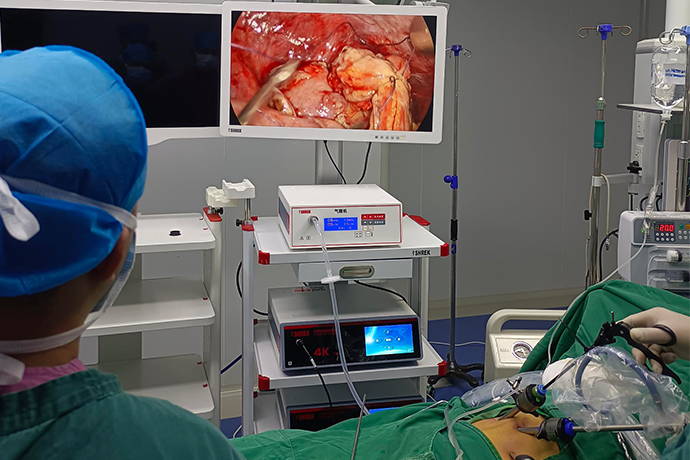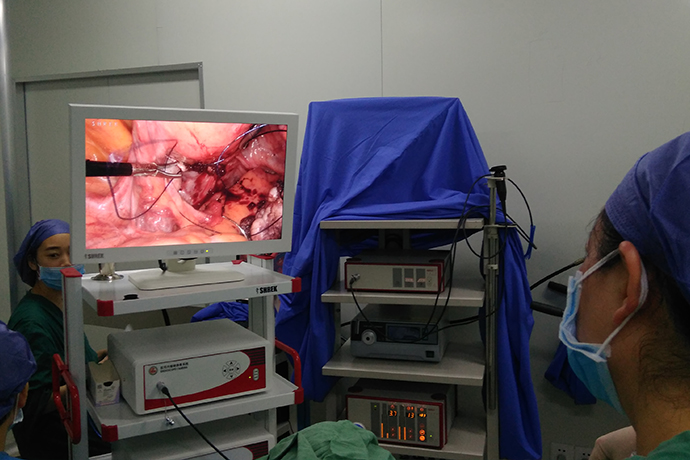[Laparoscopy] Suture Techniques Under Laparoscopy
Release time: 21 Mar 2023 Author:Shrek
Laparoscopic suturing and knotting are one of the most difficult techniques to master in laparoscopic surgery. Because laparoscopic operations are limited by space and degrees of freedom, and indirect operations are performed using instruments, it is often very difficult for beginners.

With the needle holding, adjusting and moving skills under the palm mirror, the suture technique can pass the test.
Suture
The key to suturing is to hold the needle, enter the needle, move the needle and exit the needle.
PART.1
Needle selection
Arc-shaped curved needles are generally used in the abdominal cavity, which is convenient for rotating needles under laparoscopy. The suture requires a certain degree of elasticity to facilitate the formation of coils or humps, which is conducive to knotting. The suture length of 12-15cm is more suitable for flexible suturing and knotting with endoscopic instruments in a limited space.
PART.2
Needle delivery
Clamp the suture about 1.5-2.0 cm away from the needle tail with a needle holder or separating forceps, and send it into the abdominal cavity through the operation hole.
PART.3
Throw a needle
After the suture needle is sent into the abdominal cavity, it is naturally thrown in the field of vision. When throwing the thread, place the suture needle as far as possible to form a vertical angle after the needle is held and clamped. When this position cannot be placed, the suture can also be pulled to make it just form the needle holding position.
PART.4
Needle adjustment and holding
(1) Swing needle
Use the left hand to use the separating pliers to clamp the thread and adjust the needle by pulling and rotating it so that it is placed at the position where the needle holds and clamps the needle just to form a vertical angle (needle holding position).
(2) Hold the needle
There are one-handed needle method and two-handed needle-holding method.
1) One-handed needle method: use the right hand to hold the needle directly, and use the tissue to push the needle to the appropriate position when the position is not suitable. This technique is especially useful if the assistant is not yet proficient in cooperating with you, because the forceps in your left hand, which may be used to pinch or compress the bleeding point, cannot effectively cooperate with the needle in your right hand.
2) Two-handed needle method: There are needle-thread method and needle-needle method.
Needlework method: use the left hand to clamp the needle with separate forceps, and the right hand to hold the suture with the needle, and adjust the needle to the needle holding position by pulling and rotating the suture. Then use the needle holder to clamp the junction of the rear 1/3 of the needle to complete the needle holder.
Acupuncture method: Hold the needle with both hands at the same time, and place the needle to the appropriate suture position by using both hands
(3) Needle adjustment
1) One-handed needle adjustment: also known as object-based needle adjustment, which can be adjusted with the needle point against the object, the needle tail against the object, and pricking the needle.
2) Adjust the needle with both hands: hold the needle with one hand, and hold the needle with the other hand about 1.5-2.0cm away from the end of the needle, and adjust the needle to a proper position by rotating clockwise and counterclockwise. It can be adjusted left and right, or right and left.
PART.5
Sewing skills
Insert the needle.
The appropriate needle entry angle is 65-70 degrees, the force acts on the needle tip, and the force is applied along the direction of the needle exit and the arc of the needle. Dr. Cheng Wei concluded that there are six directions of needle insertion: forward, reverse, picking, pressing, pricking, and pulling.
Needle withdrawal: use the left hand to clamp the front and middle 1/3 of the needle, hold the tissue with the needle in the right hand, rotate the left hand forceps along the arc of the needle to withdraw the needle, pull the thread with the right hand after the needle is withdrawn, or hand the needle to the right hand Dial the line with your left hand. Needle out with the right hand: The left hand clamps to fix the tissue, the right hand clamps the needle with the needle holder and rotates along the arc of the needle, and the left hand pulls the thread.
PART.6
Suture method
The laparoscopic suture method is the same as the laparotomy suture method. There are various suture methods such as interrupted suture, continuous suture, figure-of-eight suture, purse string suture, etc. Intestinal anastomosis, pancreaticoenteric anastomosis, gastrointestinal anastomosis, enteroenteric anastomosis, drainage of cyst and jejunum, vascular anastomosis, repair and bleeding point suturing to stop bleeding, etc.

- Recommended news
- 【General Surgery Laparoscopy】Cholecystectomy
- Surgery Steps of Hysteroscopy for Intrauterine Adhesion
- [Gynecological Hysteroscopy] Techniques for Preventing and Treating Complications of Hysteroscopic Surgery
- [Gynecological Hysteroscopy] Hysteroscopic Adhesiolysis
- [Gynecological Hysteroscopy] IUD Removal under Hysteroscopy